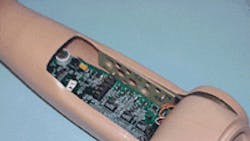Using digital signal controllers in place of analog controllers is enabling the development of artificial limbs with greater usability, as described in a recent announcement from Texas Instruments. The company’s TMS320C2000 digital signal controllers are being used in the Boston Digital Arm from Liberating Technologies to provide amputees with unique, upper limb prostheses that are dramatically more flexible and capable than existing prostheses.
The Boston Digital Arm upper limb prostheses allows users to control movement of five joints or axes, while competitive solutions only permit control of up to three joints. The added control permits a greater range of flexibility and programmability, providing patients with an optimal, customized solution and enabling more life-like movement and sensitivity. Moreover, prostheses users can apply variable amounts of force to a gripping task.
Until recently, upper limb prostheses were based on analog controls, meaning that a user relied solely on upper-arm muscle movements to control the prosthetic device. If an amputee had limited use of the upper arm muscles, however, he or she may have been unable to use prosthesis or may only have been able to benefit from a fraction of its capabilities. The power that the gripper exerted was controlled by a single predefined limit, meaning that the same amount of force used for lifting a heavy object would also be applied for holding an egg or a child’s hand.
Also, traditional artificial limbs are limited to controlling only three joints one at a time–the elbow, wrist and hand. Liberating Technologies identified control system inflexibility as the primary limiting factor in upper limb prosthetic performance and was determined to leverage the latest advancements in control technology when developing the Boston Digital Arm.
“When we developed our system we considered both microcontrollers (MCUs) and digital signal controllers,” said Bill Hanson, president, Liberating Technology. “We selected TI’s C2000 controllers because they provide vastly superior abilities to generate pulse width modulated (PWM) signals for the most efficient method of driving the dc motors that are used in prostheses. One TI digital signal controller gives us the ability to drive five motors, expandable to nine with an add-on module. In contrast, some competing solutions require two microcontrollers to drive only three motors.”
The Boston Digital Arm System, which was developed using TI’s Code Composer Studio Integrated Development Environment (IDE), is controlled by signals generated from one or more of the user’s non-injured upper limb muscles. TLV2432 operational amplifiers and INA121 BB instrumentation amplifiers from TI detect, condition and amplify the signals generated by the muscles. The C2000 controller then examines the strength of the signals, comparing them to signals from other sensors, and determines how much voltage to send to motors in the elbow, wrist and hand.
The device uses five PWM outputs to drive each motor, making it possible to go beyond the traditional arm, wrist and hand motion to, for example, provide shoulder movement for amputees without working shoulder muscles. The device also uses the controller’s input/out (I/O) options, such as a serial port interface (SPI) digital to analog converter, to control up to four additional motors on an independent prosthetic controller. This enhanced capability allows the prosthetic arm to swing instead of hanging stiffly while a person walks, providing a more natural, comfortable motion. The controllers’ additional processing power also makes it possible for users to move their joints simultaneously, making it much easier for amputees to accomplish everyday tasks like reaching and grabbing an object at the same time.
C2000 controllers integrate up to 265 kbytes of flash memory for simple reprogramming during development and in-field software updates. Optimized control peripherals include PWM generators, programmable general-purpose timers, capture modules for time stamping and glueless quadrature encoder interfaces. The C2000 platform also features up to 12-bit analog-to-digital converters that provide fast conversions—up to 12.5 Msamples/s—for tight control loops. Up to five on-chip standard communications ports, including CAN, provide simple communication interfaces to hosts, test equipment, displays and other components or networks.
